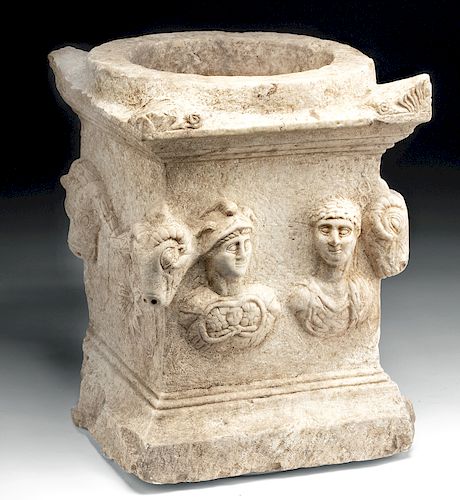Roman Marble Altar / Fountain - Minerva, Apollo, & Rams
Lot 53
About Seller
Artemis Fine Arts
686 S Taylor Ave, Ste 106
Louisville, CO 80027
United States
Selling antiquities, ancient and ethnographic art online since 1993, Artemis Gallery specializes in Classical Antiquities (Egyptian, Greek, Roman, Near Eastern), Asian, Pre-Columbian, African / Tribal / Oceanographic art. Our extensive inventory includes pottery, stone, metal, wood, glass and textil...Read more
Categories
Estimate:
$14,000 - $20,000
Absentee vs Live bid
Two ways to bid:
- Leave a max absentee bid and the platform will bid on your behalf up to your maximum bid during the live auction.
- Bid live during the auction and your bids will be submitted real-time to the auctioneer.
Bid Increments
| Price | Bid Increment |
|---|---|
| $0 | $25 |
| $300 | $50 |
| $1,000 | $100 |
| $2,000 | $250 |
| $5,000 | $500 |
| $10,000 | $1,000 |
| $20,000 | $2,500 |
| $50,000 | $5,000 |
| $100,000 | $10,000 |
| $200,000 | $20,000 |
About Auction
By Artemis Fine Arts
Feb 13, 2020
Set Reminder
2020-02-13 10:00:00
2020-02-13 10:00:00
America/New_York
Bidsquare
Bidsquare : Exceptional Antiquities, Asian, Ethnographic
https://www.bidsquare.com/auctions/artemis-gallery/exceptional-antiquities-asian-ethnographic-4848
An important one-day auction featuring museum-worthy examples of Egyptian, Greek, Roman, Etruscan, Near Eastern, Far East / Asian, Pre-Columbian, African / Tribal, Oceanic, Native American, Spanish Colonial, Russian, Fossils, Ancient Jewelry, Fine Art, so much more! Artemis Fine Arts info@artemisfinearts.com
An important one-day auction featuring museum-worthy examples of Egyptian, Greek, Roman, Etruscan, Near Eastern, Far East / Asian, Pre-Columbian, African / Tribal, Oceanic, Native American, Spanish Colonial, Russian, Fossils, Ancient Jewelry, Fine Art, so much more! Artemis Fine Arts info@artemisfinearts.com
- Lot Description
Roman, Imperial Period, ca. 1st to 3rd century CE. A beautifully carved provincial marble altar that, at a later date but still during antiquity, was transformed into a fountain by drilling out one side. The square bodied altar has a thick lip at the foot and neck with a rounded interior. The exterior is decorated with high relief carvings of important figures: Minerva (Athena) in full warrior costume as well as a youthful god, probably Apollo. The back and sides feature garlands, ram heads, and lion heads. Please see the extended description below for further discussion about the meaningful iconography presented on this piece. Size: 12.5" L x 11.5" W x 15" H (31.8 cm x 29.2 cm x 38.1 cm)
Minerva, goddess of poetry, wisdom, and warfare, was celebrated in Rome as a more peaceful goddess than Athena was in Greece; she was often depicted with her sword lowered to indicate sympathy for the battle victims. Apollo did not have a Roman equivalent, perhaps indicating that this piece was carved in a part of Greece under Roman control. In Greek religion, Apollo was often associated with compassion towards warriors, as during the Trojan War, when he was said to rescue the corpse of Sarpedon from the battlefield and clean it as well as convince Athena to stop the war for a day, so the warriors could rest. Rams, meanwhile, were a common motif on funerary altars - all suggesting that this altar likely once memorialized a soldier. When did it become a fountain? Repurposing Roman marble items happened during the Roman period and beyond, with all manner of Roman items incorporated into Christian monuments, private homes, and even pagan areas of worship in the centuries after Rome's fall. Whoever made this into a fountain must have been struck by its beauty, even if they did not fully comprehend its symbolism.
Provenance: private East Coast, USA collection; ex-William Froelich collection, New York, USA, collected in the 1960s-1990s
All items legal to buy/sell under U.S. Statute covering cultural patrimony Code 2600, CHAPTER 14, and are guaranteed to be as described or your money back.
A Certificate of Authenticity will accompany all winning bids.
We ship worldwide and handle all shipping in-house for your convenience.
#146682This was originally an altar that at some point in the past - in antiquity based on wear - was turned into a fountain. One lower corner is lost, but the item still stands on its own. Small losses from the peripheries, with wear commensurate with age. Many of the decorations are still in nice condition and their identities clear. With rich deposits on the surface.Condition
- Shipping Info
-
All shipping is handled in-house for your convenience. Your invoice from Artemis Gallery will include shipping calculation instructions. If in doubt, please inquire BEFORE bidding for estimated shipping costs for individual items.
-
- Buyer's Premium



 EUR
EUR CAD
CAD AUD
AUD GBP
GBP MXN
MXN HKD
HKD CNY
CNY MYR
MYR SEK
SEK SGD
SGD CHF
CHF THB
THB














